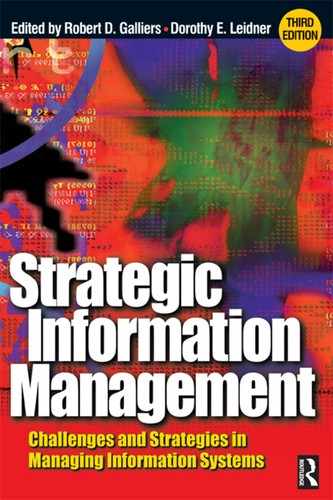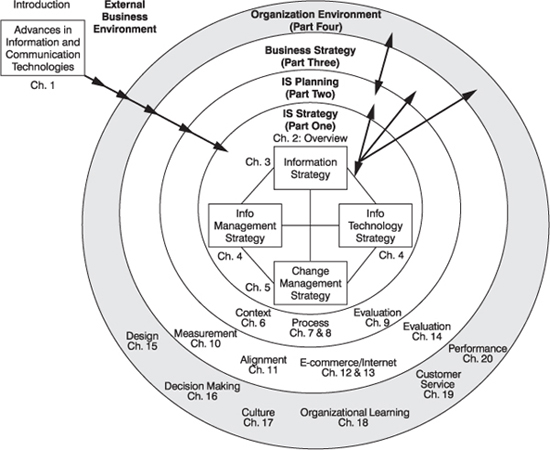Part Four
Information Systems Strategy
and the Organizational
Environment
The focus of this final part of the book is the outer shaded portion of our conceptualization of strategic information management, reproduced below as Figure IV.1. It is concerned with the wider context within which information systems strategy takes place: the organizational environment. As such, it reflects on such issues as information technology and the globalization of business;* alternative organizational arrangements; decision making in organizations, and organizational culture and knowledge management. New to this edition are chapters on the impact of IT on customer relationship management and the impact of IT on organizational learning.
Figure IV.1 The focus of Part Four: information systems strategy and the organizational environment
Part Four commences, in Chapter 15, with an article by Lambert and Peppard that looks at IT and new organizational forms. By the latter they mean structure, systems, management style, cultures, roles, responsibilities, skills and the like. The authors remind us that ‘Organizations must adopt a form that is appropriate to their strategy and the competitive position within which they find themselves’, bearing in mind the opportunities afforded by IT. A range of alternative organizational forms are presented, as is a framework which should prove useful when dealing with the myriad complex issues associated with migrating towards an appropriate new form. Their framework pays considerable attention to change management issues (cf. once again, the innermost circle of our conceptualization of strategic information management, and Chapters 5 and 6). For further reading on the general topic of organizational transformation, see Kochan and Useem (1992), from which Chapter 5 is extracted. For more on IT and organizational transformation, see, for example, Scott Morton (1991) and Galliers and Baets (1997).
We turn our attention, in Chapter 16, to the effects of information technology on organizational decision making. Written by Huber, this chapter is not alone in this collection in being of particular relevance to MBA audiences, drawing, as it does, from a range of disciplines, in this instance from the worlds of organization science and communications, as well as information systems. As Gibbons (1995) has argued, it is through trans-disciplinary research of this kind that new knowledge is more likely to be obtained. Huber's intent is to reinvestigate components of organization theory, given that much of this had been formulated ‘when the nature and mix of communication technologies were relatively constant, both across time and across organizations of the same general type’. Citing the advent of electronic mail, image transmission, computer conferencing, expert systems, external information retrieval systems, and the like, Huber sets out to explore how such new technologies as these might impact organizational forms, intelligence and decision making. A series of propositions are set forth, connected with constructs and concepts, from which a conceptual theory is developed. He concludes, inter alia, that researchers in organization science ‘should study advanced information technology as . . . an intervention or jolt in the life of an organization that may have unanticipated consequences with respect to evolved organizational design’. The collective experiences of our readers are likely to conclude that he is right on this score! More positively, he also concludes that IT is likely to improve decision making and enable new organizational forms. Reasons for possible impediments to the former, however, are uncovered in Chapter 19 that then follows. For further reading on IT and organizational structure and decision making, see, for example, Fiedler et al. (1996), Leidner and Elam (1993, 1995), Molloy and Schwenk (1995), Orlikowski and Robey (1991) and Tavakolian (1989).
In Chapter 17, Leidner reflects on the issues associated with current attempts to implement knowledge management systems (KMS) in organizations and their, at times, limited impact, due to clashes with corporate culture. The author introduces the chapter with an insightful account of developments over the years in information systems designed to support managerial and operational activity in organizations, preceding the more recent developments in KMS. Providing a complementary account to that presented in Chapter 1, Leidner focuses attention on the implementation effects and requirements of various types of information system, from management information systems (MIS), to decision support systems (DSS), to executive information systems (EIS), to KMS. She notes a trend from a ‘one system for all users’, to a ‘one system for one user’, to an ‘anyone, anywhere, anytime’ information provision strategy in line with these developments. Reflecting on organizational culture issues, Leidner illustrates how the necessity for user participation in the information systems development and design process has progressed, in the light of these developments, from involvement during earlier stages of analysis and design to active contribution of user knowledge with KMS. This is where her concept of information culture comes in, with a series of propositions that help illustrate, inter alia, the circumstances in which knowledge is more or less likely to be shared by actors in organizations, dependent on their view as to whether this information is an individual or corporate asset.
While knowledge management may be considered a relatively new topic, it is in essence an extension of the broader issue of organizational learning. Chapter 18 offers an interesting analysis of the introduction of IT in an organization and subsequent learning. Pentland views organizations as knowledge systems composed of a collection of knowledge processes, including constructing, organizing, storing, distributing, and applying. Pentland analyses the case of a small engineering consulting company that implemented a new information system to automate one of its core business activities. He shows how information systems influence not only the objects of knowledge but also the criteria for knowledge construction.
Chapter 19 introduces a topic new to this edition, that of improving customer support with information systems. El Sawy and Bowles provide insights for designing IT-enabled customer support processes that enable a company to meet the requirements of operating in a fast response, internetworked world. The system they describe provides an infrastructure for problem resolution that includes a customer support knowledge base whose structure is dynamically updated based on adaptive learning through customer interactions. Whereas the previous chapter focuses on individuals learning through information systems, this chapter poses the opportunity of systems learning through the information input by people. El Sawy and Bowles provide observations that can be useful starting points for any firm wanting to think of ways to utilize information technology to improve customer relationships.
We conclude, in Chapter 20, with a look at what has been termed the IT productivity paradox – the problem that many organizations face in obtaining business advantage from their IT, despite the dramatic developments in the technology that we have witnessed over recent years, and despite the considerable investment made in this technology by many companies. Written by Willcocks and Lester, it proposes a means of linking business and information systems strategy by prioritizing IT investments, setting interlinking performance measures and considering external IT services as well as internally developed solutions. In many ways, then, the holistic stance taken by the authors makes Chapter 20 an appropriate place to bring our consideration of strategic information management to a close, since it tries to integrate many – although by no means all – of the issues raised in the book. The overall intention of the chapter, as well as Strategic Information Management as a whole, has been to enable organizations to obtain greater business value from their investments in IT. This can only be achieved by executives understanding the issues, getting involved and taking responsibility in this key area. We hope we have gone some way in assisting in this process.
References
Castells, M. (2001). The Internet Galaxy, Oxford University Press, Oxford.
Fiedler, K. D. Grover, V. and Teng, J. T. C. (1996) An empirically derived taxonomy of Information Technology structure and its relationship to organizational structure. Journal of Management Information Systems, 13(1), Summer, 9–34.
Galliers, R. D. and Baets, W. R. J. (1998) Information Technology and Organizational Transformation: Innovation for the 21st Century Organization, Wiley, Chichester.
Gibbons, M. (1995) The New Production of Knowledge: The Dynamics of Science and Research in Contemporary Societies, Sage, London.
Kochan, T. A. and Useem, M. (eds) (1992) Transforming Organizations, Oxford University Press, New York.
Leidner, D. E. and Elam, J. J. (1993) Executive information systems; their impact on executive decision making. Journal of Management Information Systems, 10(3), 139–156.
Leidner, D. E. and Elam, J. J. (1995) The impact of executive information systems on organizational design, intelligence and decision making. Organization Science, 6(6), 645–665.
Molloy, S. and Schwenk, C. R. (1995) The effects of Information Technology on strategic decision making. Journal of Management Studies, 32(5), 283–311.
Orlikowski, W. and Robey, D. (1991) Information Technology and the structuring of organizations. Information Systems Research, 2(2), 143–169.
Porter, M. E. (1990) The Competitive Advantage of Nations, Macmillan, Basingstoke.
Scott Morton, M. S. (ed.) (1991) The Corporation of the 1990s: Information Technology and Organizational Transformation, Oxford University Press, New York.
Tavakolian, H. (1989) Linking the Information Technology structure with organizational competitive strategy: a survey. MIS Quarterly, 13(3), September, 309–319.
Walsham, G. (2001). Making a World of Difference: IT in a Global Context. Wiley, Chichester.
* See also, for example, Walsham (2001) and Castells (2001).

